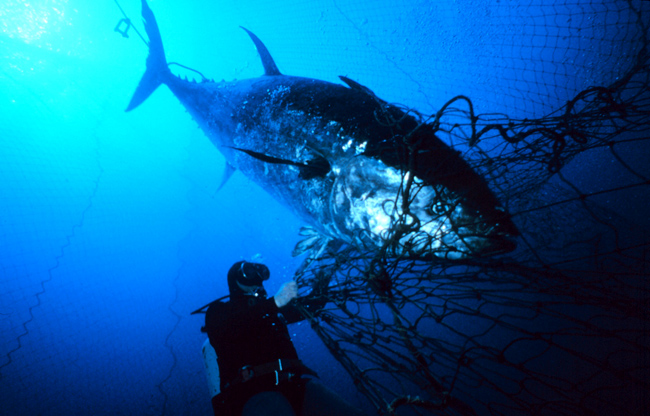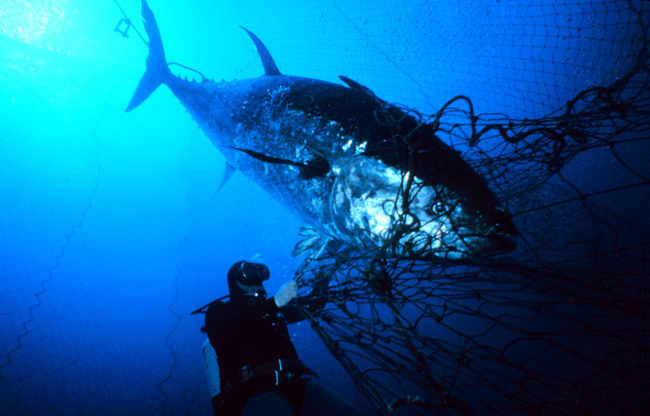Dear Umbra,
Big, mature tuna have a lot of mercury in their bodies and are often caught with longlines that snag endangered sea turtles and sea birds; smaller juvenile tuna have less mercury, swim near the surface so they can be caught with less destructive fishing gear, but they have not had the chance to do all of their reproducin’, which threatens the stability of future tuna populations. Which is a better choice?
Michael F.
San Francisco, Calif.
Dearest Michael,
Have you noticed that tuna are a gigantic fish? A (lucky) bluefin tuna can grow to weigh over a thousand pounds, and be nine feet long. That’s the same size as a male polar bear. In fact, given what I’m about to advise, it may help to think of tuna as the polar bear of the oceans.

The polar bear of the seas?
NOAA.gov
Polar bears are cute, cuddly, and everyone is sad that they might run out of ice and become extinct like the pathetic animated bear in An Inconvenient Truth. Tuna are neither cute nor cuddly, and no one is winning a Nobel Prize for a touching movie about their imminent demise. For the average American, though, the status of the tuna fishery has bigger implications for daily life than the status of the polar bear.
Basically, it’d be great if we all stopped eating tuna, for both of the reasons you mention: due to being high on the food chain, they often contain high levels of mercury (a byproduct of industry, particularly coal-fired power plants); and many species are overfished. Longlines, the sixty-foot-long baited lines used to catch many kinds of tuna, have a high bycatch. Purse seining for Pacific yellowfin tuna was responsible for all those dead dolphins, but this has apparently been improved.
No official agency is going to recommend that we stop eating tuna because a) the tuna people would be annoyed; b) when has the government ever told us to stop doing anything bad (have you seen cigarette labels in Europe?); and c) eating fish is still kind of good for you. And we love our tuna: Americans ate about 2.7 pounds of canned tuna per person in 2007.
If you’re not willing to change your tuna (sorry), here are a few ideas: If you can find local tuna, you very well may be able to ignore some of the mercury warnings. Plus, you’re a man. Children and women of childbearing age should not be eating much canned tuna, due to the dangers of developmental problems from mercury poisoning. See the maximum amount of tuna you should be eating here.
For most of us, it’s impossible to tell whether the tuna we wish to chew was killed when young or old. So when fishy questions arise, it’s helpful to turn to the many seafood guides available and choose by species instead of age. I like the NOAA FishWatch, which gives oodles of information, including how a fish is caught, sustainability status, lifecycle, etc. The Environmental Defense Fund has a very detailed list, and includes information about environmental contaminants. Albacore and yellowfin tuna caught in the U.S. and Canada make their “best” list; bigeye and yellowfin caught internationally on longlines are worst, as is bluefin. As you can see, it’s complex, so I think you should print a guide and keep it with you. Greenpeace and the Monterey Aquarium also offer guides.
Let me repeat: the easiest step of all would be to just stop eating tuna. Tuna is tasty, but it is suffering. And you probably wouldn’t eat a polar bear, even if it came in a handy can.
Comparatively,
Umbra

